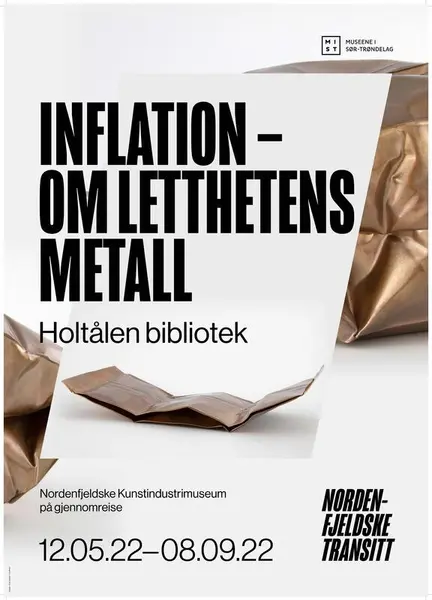- 1/1
Copper is one of the softest metals. Thanks to its flexibility and chemical qualities, it has been a favoured material in art. In Western art history we find several famous art works made of coper. We can mention the Colossus of Rhodes (200 BCE), the equestrian statue of Marcus Aurelius in Rome (176 CE), and the Statue of Liberty in New York (1886), made with coper from the island of Karmøy in Norway. During the Renaissance, coper was used as a pigment in paintings. In Chinese art, copper has been second only to iron as the most important pigment in ceramic glazes, not least because it can be used to produce many colours ranging from light green to deep red. In modern metal art, artists have used the natural patina of coper as part of their artistic expression.
The work Inflation (2019), by Stian Korntved Ruud, consists of seven coper objects shaped like paper bags containing microwave popcorn. In a sense, these are all the same bag: we see different stages in a time sequence as the popcorn bag gradually inflates. The instantaneous experience of a whole time span can tell a story about the material’s lifecycle. This cycle begins with the mining of ore; the ore is then processed to separate the copper from other materials, then the concentrated copper is in turn processed and ends up as an object. As an image of time, the art work also alludes to the material’s ‘death’, given that copper oxidises (turns green) and ultimately disintegrates. When a life-long period of time is brought together in a single frozen moment such as we see in Inflation, we can experience time with a lightness that is reflected in a soft and light material such as copper.
Stian Korntved Ruud was born in Bærum, Norway, in 1989. He is interested in the aesthetic qualities of materials and creates handmade objects in natural materials. He studied product design at Akershus University College (now Oslo Met) and at Oslo School of Architecture and Design. In 2015 Ruud won the prestigious Craft Prize, awarded by Bildende Kunstners Hjelpefond.

